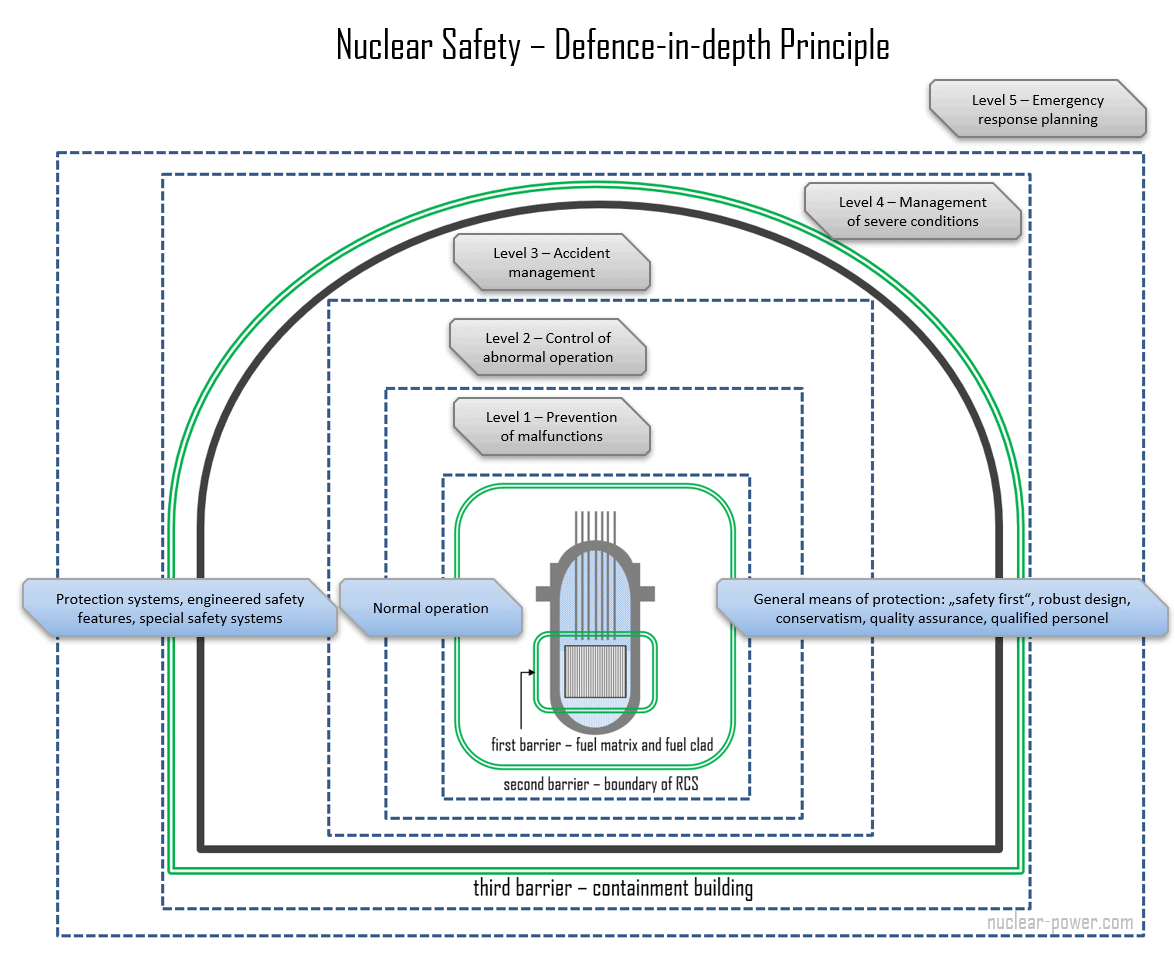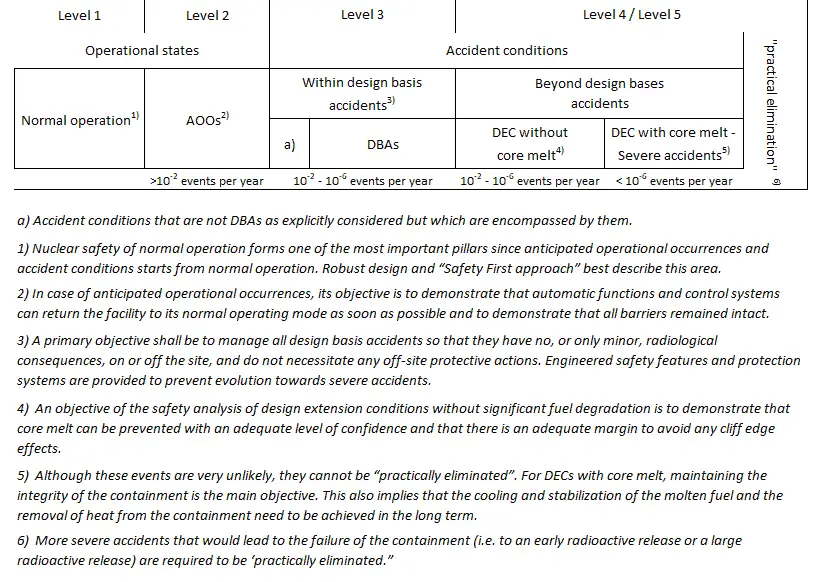Nuclear safety, also known as reactor safety, is defined by IAEA:
‘Safety’ is the achievement of proper operating conditions, prevention of accidents, and mitigation of accident consequences, resulting in protecting workers, the public, and the environment from undue radiation hazards.
This definition covers more than it may seem. Nuclear safety is a broad engineering concept that ranges from nuclear engineering to the theory of human errors. Nuclear safety is composed of technical and organizational measures taken during all phases of a facility’s life (design, construction, commissioning, operation, decommissioning and dismantling) to protect workers, the general public, and the environment from the effects of radioactive substances.
Five levels of defense
Most nuclear power plants introduce a ‘defense-in-depth ‘approach to achieve maximum safety. This approach is constituted of multiple safety systems supplementing the natural features of the reactor core.
According to INSAG-10:
“Defence in depth consists in a hierarchical deployment of different levels of equipment and procedures to maintain the effectiveness of physical barriers placed between radioactive materials and workers, the public or the environment, in normal operation, anticipated operational occurrences, and, for some barriers, in accidents at the plant.”
Defense in depth ensures that a plant is designed, fabricated, constructed, and operated not only to be safe during normal operation but to account safely for the possibility of a spectrum of accidents. The plant has sophisticated safety systems and devices to guard against human error, equipment failures, and malfunctions taking into account such natural phenomena as earthquakes, tornadoes, and floods.
The main reason for this approach lies in the uniqueness of nuclear power plants. Nuclear reactors have three unique characteristics that affect their safety compared to other power plants.
Three characteristics that affect nuclear safety
- High energy density. Nuclear power reactors contain large amounts of energy stored in nuclear fuel. A criticality accident (a rapid increase of the reactor power) is possible in certain reactor designs if the chain reaction cannot be controlled. Reactors must be designed with negative reactivity feedback to control this type of characteristic, and plant operators must control reactivity of the system.
- Decay heat. Fission essentially ceases when a reactor is shut down, but decay energy is still produced. The energy produced after shutdown is referred to as decay heat. The reactor’s design must remove this decay heat from the core by some means. If adequate heat removal is not available, decay heat will increase the temperatures in the core. This feature is why nuclear power plants have multiple emergency core cooling systems stages.
- Presence of radioactive materials. The nuclear fission reaction produces radioactive nuclei known as fission fragments. Most of these fission fragments are radioactive, and their confinement in operation or accidents is of the highest importance in nuclear safety. This is the main reason why the safety of nuclear power reactors is based on the three protective barriers.
These are the three main characteristics of nuclear reactors and their related safety measures. This covers nuclear power plants and all other nuclear facilities, the transportation of nuclear materials, and the use and storage of nuclear materials for medical, power and industry. However, perfect safety cannot be guaranteed. Potential sources of problems include human errors and external events that have a greater impact than anticipated. It must be added, no industry is immune from accidents, but all industries learn from them. In the chemical and oil-gas industries, major accidents also improve safety. There is a wide public acceptance that the risks associated with these industries are an acceptable trade-off for our dependence on their products and services. In reality, the safety record of nuclear power plants, by comparison with other electricity generation sources, is very good. The use of nuclear energy for electricity generation can be considered extremely safe. Every year several thousand people die in coal mines to provide this widely used fuel for electricity. There are also significant health and environmental effects arising from fossil fuel use.
Three fundamental safety functions of nuclear safety
Three safety functions associated with the three characteristics are a prerequisite to ensuring reactor safety under all circumstances:
- Control of the chain reaction and the power generated by it.
- Cooling of the fuel also after the chain reaction has stopped, i.e., removal of residual heat.
- Isolation of radioactive products from the environment.
Reactor safety is based on three protective barriers to prevent radioactive releases and the defense-in-depth principle.
Three protective barriers
Three protective barriers refer to a series of strong and leak-tight physical barriers between radioactive products and the environment. The barriers prevent the release of radioactive products in all circumstances. The goal of defense-in-depth, introduced in the preceding section, is to ensure basic safety functions, i.e., controlling reactivity, cooling irradiated fuel and containing radioactive substances. These safety functions are necessary to ensure all barriers remain effective.
Classification of Plant States

